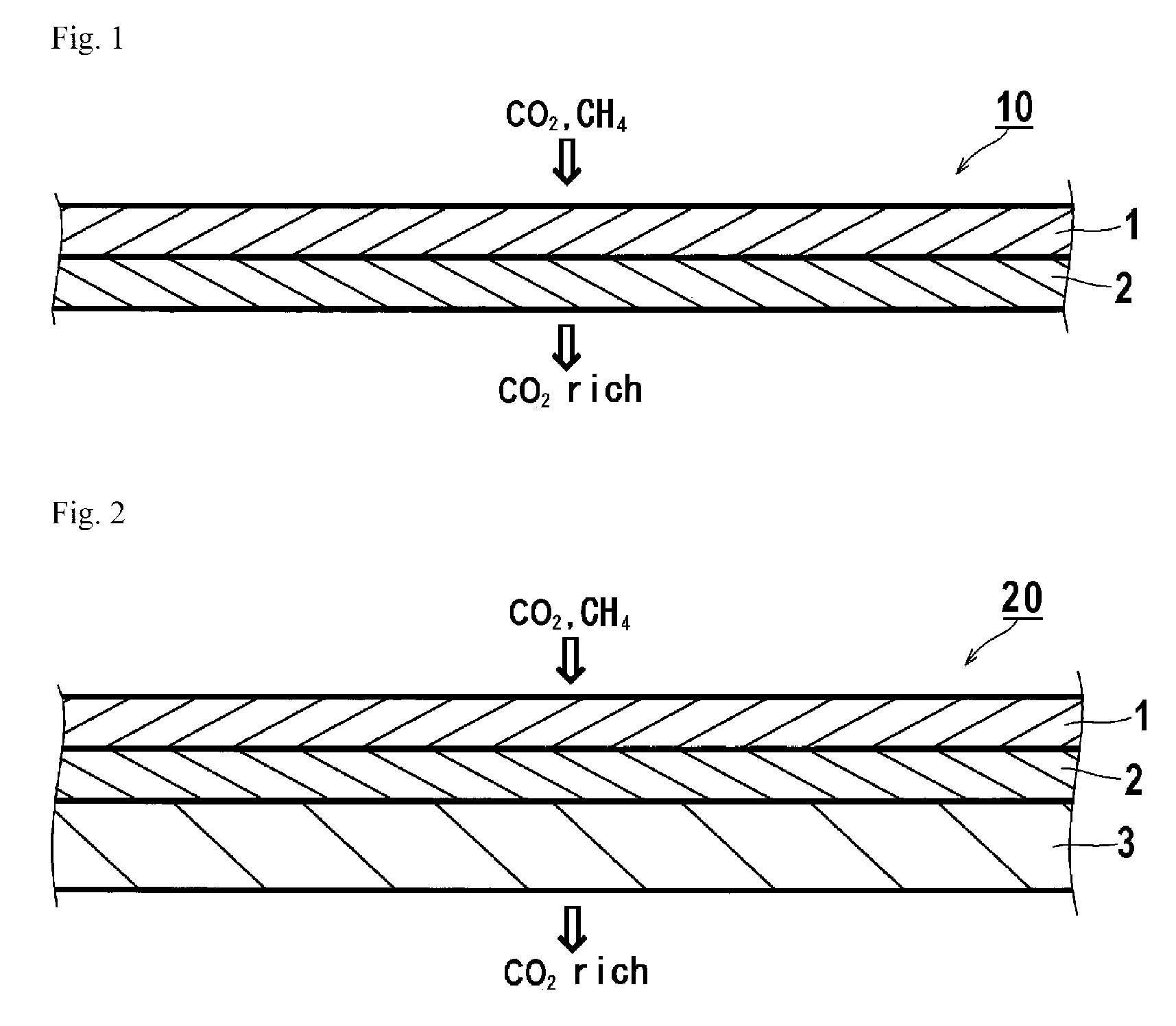Gas separation composite membrane, and gas separating module, gas separation apparatus and gas separation method using the same
a gas separation and composite membrane technology, applied in the direction of membranes, separation processes, membranes, etc., can solve the problems of reducing the selectivity of separation due to plasticization, damage to membrane raw materials, etc., and achieve excellent gas permeability, high gas separation selectivity, and high membrane forming competence and stability.
- Summary
- Abstract
- Description
- Claims
- Application Information
AI Technical Summary
Benefits of technology
Problems solved by technology
Method used
Image
Examples
examples
[0192]Hereinafter, the present invention will be described in more detail with reference to examples, but the present invention is not limited to these examples. In addition, “part” and “%” is based on mass, unless otherwise particularly described.
synthesis examples
Synthesis of Monomers (M-1) to (M-4)
[0193]The monomers (M-1) to (M-4) were synthesized, in accordance with the following reaction scheme.
[0194]
Synthesis of Compound (2)
[0195]Into a 1,000 mL three-necked flask, 23.1 g of 3-aminoquinuclidine dihydrochloride (product number: 327-38592, 0.116 mol, manufactured by Wako Pure Chemical Industries, Ltd.) and 230 mL of toluene were put, and the resultant mixture was stirred under ice-cooling under nitrogen flow, and thereto, a sodium hydroxide (18.6 g) / tetrabutylammonium bromide (0.3 g) / water (186 mL) aqueous solution was added. Further, the resultant mixture was stirred under ice-cooling, and thereto, 100 mL of toluene solution of 26.8 g (0.116 mol) of 3,5-dinitrobenzoylchloride (1) was added dropwise. After completion of the dropwise addition, the resultant mixture was stirred for 1 hour under ice-cooling, further heated to room temperature, and stirred for 4 hours. Water was added to the resultant reaction mixture, produced crystals were f...
example 1
[0217]In a 30 mL brown vial, 1.4 g of the polymer (P-1), 0.038 g of a crosslinking agent (M-5, product number: A0926, manufactured by Tokyo Chemical Industry Co., Ltd.) and 8.6 g of tetrahydrofuran were mixed, the resultant mixture was stirred for 30 minutes, and then 1.4 mg of 1-hydroxycyclohexyl phenyl ketone (product number: 40, 561-2, manufactured by Sigma-Aldrich Corporation) were further added thereto, and the resultant mixture was further stirred for 30 minutes. On a 10 cm square clean glass plate, a polyacrylonitrile porous membrane (manufactured by GMT Membrantechnik GmbH) was left to stand, the polymer liquid was cast on a surface of the porous support membrane, and the resultant material was immediately exposed at 10 mW for 60 seconds using light curing apparatus (TCT1000B-28HE) manufactured by Sen Lights Corporation, and thus a hardened membrane sample No. 101 was obtained. The thickness of polymer (P-1) layer was about 1.1 μm, and the thickness of the polyacrylonitrile ...
PUM
| Property | Measurement | Unit |
|---|---|---|
| temperature | aaaaa | aaaaa |
| thickness | aaaaa | aaaaa |
| thickness | aaaaa | aaaaa |
Abstract
Description
Claims
Application Information
 Login to View More
Login to View More - R&D
- Intellectual Property
- Life Sciences
- Materials
- Tech Scout
- Unparalleled Data Quality
- Higher Quality Content
- 60% Fewer Hallucinations
Browse by: Latest US Patents, China's latest patents, Technical Efficacy Thesaurus, Application Domain, Technology Topic, Popular Technical Reports.
© 2025 PatSnap. All rights reserved.Legal|Privacy policy|Modern Slavery Act Transparency Statement|Sitemap|About US| Contact US: help@patsnap.com



